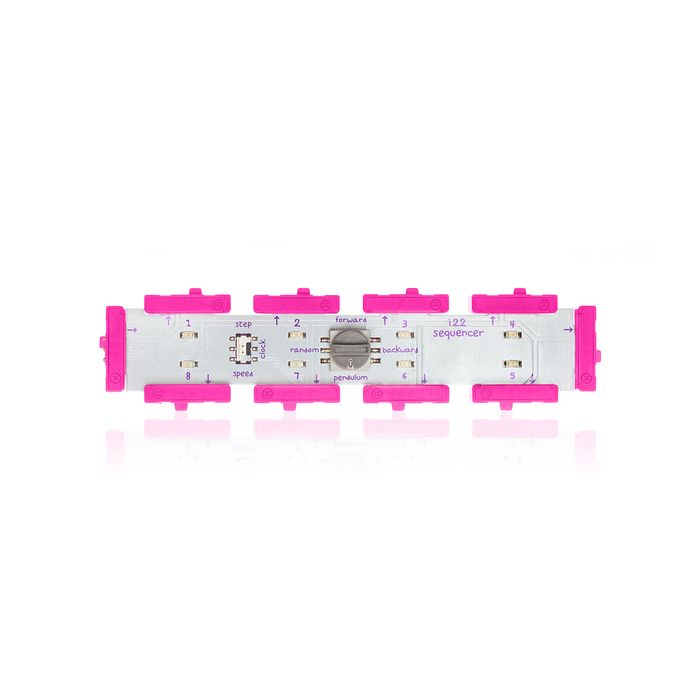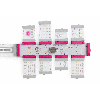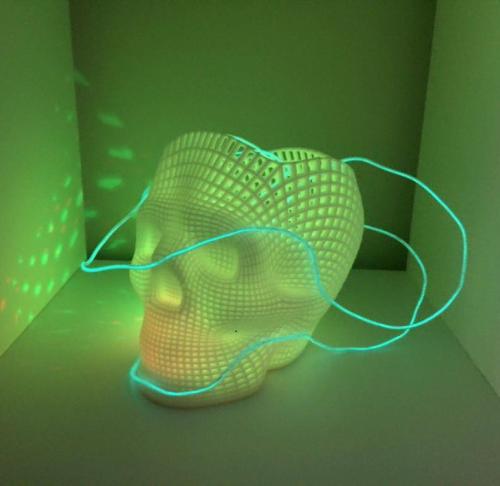littleBits Sequencer
Available with a lead time
Expect dispatch between Jan 14 and Jan 16
Quantity Discounts:
- 6+ $74.88 (exc GST)
- 12+ $72.54 (exc GST)
The sequencer allows you to connect up to eight outputs and control them in sequential patterns. Sequences that would take as long as 4 days to program without littleBits will only take you seconds!
- Automatically cycle through the entire sequence
- Control the speed of the sequence using dimmers or sensors
- Run the sequence four ways: forwards, backwards, pendulum, or random
- Swap automation for full control and step through each part of the sequence using a button, sound trigger, or any other high signal input
Check out littleBits Sequencer Tips + Tricks!
GEEK SPEAK
There are two clock modes that control when the module transitions from sequence step to sequence step. In “step” mode the sequence transitions to a new sequence step on input low-to-high transitions. In this mode, the clock output is high when the input is above 2.5V, and the clock output is low when the input is below 2.5V.
In “speed” mode the sequence transitions to a new sequence step at a fixed frequency. The step frequency is proportional to the voltage at the input. At 0V input, the frequency is 0Hz (the sequencer does not step). At 5 volts the step frequency is approximately 80Hz. In this mode, the clock output is a square waveform at the step frequency The four sequence modes control the order in which the 8 sequenced outputs are activated. At any given time, there is exactly one of the 8 sequenced outputs set to 5V. All other outputs are set to 0V.
“Forward” mode sets output 1 to 5V, then on the next step output 2 is set to 5V, and so on. After activating each output in turn, the sequence then continuously repeats, starting at output 1.
“Backwards” mode is the same as “forward” mode, except that the sequence steps from output 8 to output 1 and is set to 5V at each step.
“Pendulum” mode sets output 1 to 5V, then on the next step output 2 is set to 5V, and so on. Upon reaching output 8, the sequence reverses and steps down from 7 to 1.
“Random” mode sets a randomly selected output to 5V at each step.
UNDER THE HOOD
The input signal is buffered by an opamp (U1), then passed through a single pole RC low pass filter, then a 2-pole active low pass filter (U3). The combined filters band limit the signal to 160Hz with an 18dB per octave filter slope. This signal is split into two paths. One path leads to the Analog-to-Digital Converter (ADC) of an Atmel ATMEGA168 microcontroller (U2). The other path leads to a General Purpose Input-Output (GPIO) pin on the same microcontroller. The path to the ADC is used in “speed” mode because in speed mode, we need to precisely measure the input voltage, and the ADC is precise. The path to the GPIO pin is used in “step” mode, because we need to quickly measure the timing of an input low-to-high transition, and the GPIO pin responds very quickly to transitions. Depending on the clock mode, microcontroller converts the measured input values into either the sequencer step speed in “speed” mode, or simply goes to the next sequencer step when it detects a low-to-high transition in “step” mode. These values are translated into signals that control the pins of the microcontroller connected to the various outputs.
Have questions? Mingle with the pros on littleBits forum!
Technical Details:
- Dimensions (mm): 1.13(H) x 0.06(W) x 4.63(D)
- Product Weight: 0.02 lbs (0.01 kg)
- Recommended Age: 8+
- SKU: 650-0008
- UPC: 810876020299
- Extra Materials Circuit Diagram - PDF
Exact shipping can be calculated on the view cart page (no login required).
Products that weigh more than 0.5 KG may cost more than what's shown (for example, test equipment, machines, >500mL liquids, etc).
We deliver Australia-wide with these options (depends on the final destination - you can get a quote on the view cart page):
- $3+ for Stamped Mail (typically 10+ business days, not tracked, only available on selected small items)
- $7+ for Standard Post (typically 6+ business days, tracked)
- $11+ for Express Post (typically 2+ business days, tracked)
- Pickup - Free! Only available to customers who live in the Newcastle region (must order online and only pickup after we email to notify you the order is ready). Orders placed after 2PM may not be ready until the following business day.
Non-metro addresses in WA, NT, SA & TAS can take 2+ days in addition to the above information.
Some batteries (such as LiPo) can't be shipped by Air. During checkout, Express Post and International Methods will not be an option if you have that type of battery in your shopping cart.
International Orders - the following rates are for New Zealand and will vary for other countries:
- $12+ for Pack and Track (3+ days, tracked)
- $16+ for Express International (2-5 days, tracked)
If you order lots of gear, the postage amount will increase based on the weight of your order.
Our physical address (here's a PDF which includes other key business details):
40 Aruma Place
Cardiff
NSW, 2285
Australia
Take a look at our customer service page if you have other questions such as "do we do purchase orders" (yes!) or "are prices GST inclusive" (yes they are!). We're here to help - get in touch with us to talk shop.
Have a product question? We're here to help!
Guides
The Maker Revolution
What is the better tech, innoBits or littleBits?
Projects
The One Wand to rule them all!
littleBits Death Eater Skull!
Makers love reviews as much as you do, please follow this link to review the products you have purchased.














Product Comments